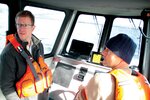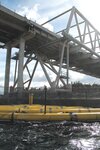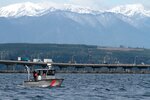The Hood Canal Bridge is a dead end.
It is, at least, for salmon trying to get past it.
U.S. Rep. Derek Kilmer got a first-hand look last week at what’s largely become a 2-kilometer-long …
This item is available in full to subscribers.
We have recently launched a new and improved website. To continue reading, you will need to either log into your subscriber account, or purchase a new subscription.
If you had an active account on our previous website, then you have an account here. Simply reset your password to regain access to your account.
If you did not have an account on our previous website, but are a current print subscriber, click here to set up your website account.
Otherwise, click here to view your options for subscribing.
* Having trouble? Call our circulation department at 360-385-2900, or email our support.
Please log in to continue |
Need an account?
|



The Hood Canal Bridge is a dead end.
It is, at least, for salmon trying to get past it.
U.S. Rep. Derek Kilmer got a first-hand look last week at what’s largely become a 2-kilometer-long Death Row for juvenile steelhead that are headed to the sea.
The 6th District congressman also got an extensive on-water briefing on what Long Live the Kings hopes will be a fish-saving solution: a “fish guidance structure” called a fillet that can be seasonally bolted into the 90-degree corners of the bridge’s pontoons.
It’s those sharp corners at the waterline of the bridge that essentially trap fish like steelhead on the south side of the span.
Most fish are unable to swim around those corners, making that side of the bridge a predictable underwater buffet table for harbor seals and other predators.
“There are millions of fish that are held up by the bridge,” said Hans Daubenberger, a senior research biologist with the Port Gamble S’Klallam Tribe.
A “fillet” was installed on the east end of the Hood Canal Bridge in spring, and by using tagged fish and acoustic monitors placed on the span, researchers are studying to see if the fish guidance structure is successfully steering steelhead away from being trapped at the bridge.
“When you look at this from the bridge standpoint, this is 2 kilometers long. And that looks very small. What’s the big deal?” Daubenberger asked rhetorically as he steered a small research boat along the span April 12.
“That thing sticks out about
20 meters,” he added, pointing to the end of a pontoon perpendicularly extending from the south side of the bridge.
“And for a 6-inch fish, it’s basically forever. They swim along the structure. They go along the bridge, they get to that corner, and they turn around and go back the other way because it looks like a wall.”
PROBLEM RUNS DEEP
The pontoons also extend 15 feet below the surface of the water. That’s another big problem for fish that have grown up in just a few feet deep of river water.
“All these fish, they’re very surface-oriented,” Daubenberger said.
The fish swim in the top 3 feet of the water column, and stay there when the food supply is abundant.
“They see the bridge as a full barrier,” he explained. “They really don’t go under it unless they are forced.”
Researchers note that up to 50 percent of threatened juvenile steelhead that get to the bridge never make it past. Other young salmon are also impacted.
There are probably several reasons why steelhead are surface-oriented, he said. The surface of the water column is less salient, and the fish are transitioning from their life cycle in fresh water to a marine environment.
“That’s a pretty challenging physiological process,” Daubenberger explained.
“Being in a little less salty water is probably advantageous to them. They are also visual feeders, so they need light to feed. So that probably plays a role.”
TROUBLE AT THE TOP
Usually during the daytime, most juvenile salmon are pretty surface- and shore-oriented, Daubenberger said. But at night they’ll kind of evenly distribute themselves.
During windstorms and the change in tides, they will also get blown offshore.
“That’s how we think they end up on the bridge,” he said.
“At night, when they are moving along, they’re just kind of evenly distributed. Then they get to the bridge and they sort of get stuck there.”
The 90-degree traps on each end of the bridge create a sort of treadmill for steelhead, caught in a potential death loop from swimming from one end to the other, then back again.
Unlike a shoreline that slopes and gets shallower, providing fish places where seals can’t chase them, there’s not a lot of natural vegetation like eelgrass beds and habitat where salmon can avoid predators.
“It’s basically just this flat wall, which creates a really unique opportunity for seals to feed on fish,” he said.
“It acts like a dam. It’s really like a wall,” Daubenberger explained.
Another element keeps many of the fish frozen in place.
“There’s also a big tidal eddy that forms because of that corner being 90 degrees. And so what we’re basically trying to do with the project is alleviate that transition,” he said.
That’s where the fillet comes in. The massive triangular structure — which weighs about 70,000 pounds out of the water, is
21.5 feet tall, and has sides that stretch
60 by 60 by 85 feet long — round out the hard corners along the 2-kilometer length of the floating bridge span.
“The idea is the fish can swim along the structure and instead of turning around, they go around rather than in,” he said.
The Hood Canal Bridge blocks most, but not all, of Hood Canal at the surface of the water. Experts estimate that the pontoons span 83 percent of the width of the canal.
Add to that the problem of fish food.
The lighting and some of the tidal circulation that’s unique to the bridge holds zooplankton in a way that really isn’t normal.
Krill, for example, are usually found near the bottom in a layer about 100 meters deep, rising to the top at night to feed, then migrating back down during the day.
“Here at the bridge, they kind of just come up and stay there,” he said.
That’s a problem because it creates a nonstop foraging option for fish.
It acts as an attractive nuisance, he added.
“The fish stick around,” Daubenberger said.
The Hood Canal Bridge is one of the biggest problems for fish passage in the state.
While previous studies at the bridge have focused on water quality, the second phase of work has been to develop and test solutions for reducing fish mortality without impacting the bridge as a major transportation corridor.
The fillet will be in place for six weeks of testing, then towed to a marina where it will be stored.
LOOKING FOR CLUES
During the testing, biologists will examine data from tagged fish that are headed toward the bridge. Researchers will use data collected from acoustic devices installed on the bridge to see if the fillet has caused a change in the behavior of fish and their predators. The survival rate will also be estimated with fillets in place, and without.
The fillet structure was designed by Kleinschmidt Group and Art Anderson and Associates, and was built in Kingston by Pacific Netting Products.
The skeleton of the fillet is made up of a series of high-density polyethylene pipes; some filled with water, some hollow. The mix of pipes creates a precise buoyancy so it sits just at the water line.
On top of the fish guidance structure, netting has been installed to keep sea lions and seals from jumping into the fillet.
The first fillet cost $1.6 million to construct, and Long Live the Kings, the coordinators of the project, estimate future fillets will cost about $1.4 million to construct. Long Live the Kings is a nonprofit committed to salmon and steelhead restoration in the Pacific Northwest.
The project is expected to cost about
$11.7 million through 2025, and roughly
$5.9 million has been raised to date.
A total of $3.6 million for the project was appropriated by the Washington State Legislature during the 2021-2023 biennium.
Partners in the project include the Hood Canal Coordinating Council, the National Oceanic and Atmospheric Administration, the Pacific Northwest National Laboratory, the Port Gamble S’Klallam Tribe, the Skokomish Indian Tribe, Navy, U.S. Fish and Wildlife Service, Washington Fish and Wildlife, and Washington State Department of Transportation.
During last week’s tour, Kilmer peppered Daubenberger with questions as the small research boat maneuvered its way to the bridge from Salsbury Point County Park, through waves whipped up by 13 mph winds; the cost, the analysis, future funding needs, the role of the federal government.
“They don’t look very impressive right now,” Daubenberger said as the boat approached the fillet, noting that not much of the fish guidance system could be seen above the waterline.
“This thing’s like an iceberg; it’s really big underneath,” he added.
Two end fillets are the most vital, but Daubenberger said it hasn’t yet been determined if more should be added to the length of the bridge.
The critical need, he said, is to put another on the west end.
“So $1.5 million more,” Kilmer responded.
POTENTIAL FEDERAL FUNDING
Kilmer noted the assistance already provided by National Oceanic and Atmospheric Administration and other federal agencies.
“A lot of the work we’ve been doing on Puget Sound recovery through the Environmental Protection Agency provides funding for this,” Kilmer said.
The Bipartisan Infrastructure Law, signed into law by President Biden in November 2021, included $172 million for the NOAA Pacific Coastal Salmon Recovery Fund, a grant program that provides funding to states and Tribes to protect, conserve, and restore West Coast salmon.
“We’ve been trying to lay the seeds. In the transportation budget the last few years we’ve put in language related to physical structures that have impacts on endangered species,” Kilmer said.
Other items that may interest you
